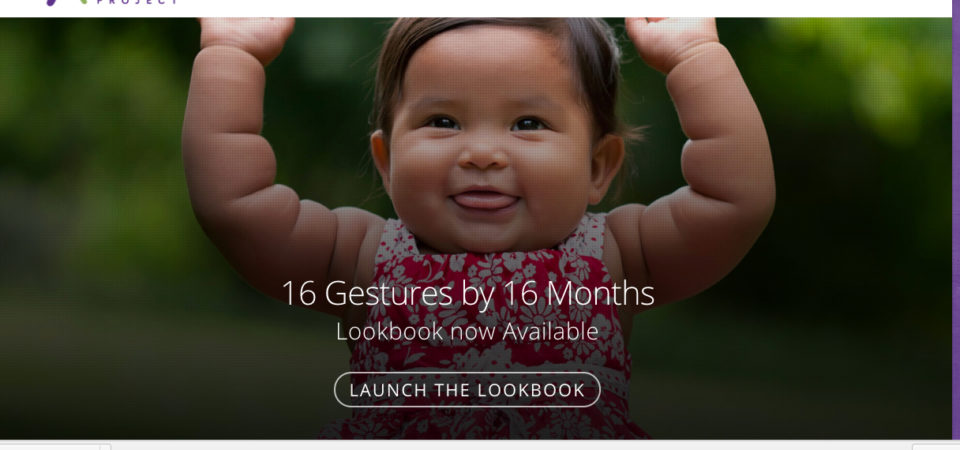16 Gestures by 16 Months can help parents track progress
- January 12, 2018
- / Shannon Nickinson
- / category-feature

The resources to help parents know, understand and track their child’s early brain development are growing all the time.
And Studer Community Institute wants to share those tools as part of building an Early Learning City in Pensacola and Escambia County — where data indicate nearly 34 percent of children are not ready for school.
Data from the Institute’s Pensacola Metro Dashboard — a set of 16 metrics that gauge the educational, economic and social well-being of the community — indicates that nearly one-third of Escambia County’s kindergartners are not ready for school on the first day.
Research indicates that readiness gap could result because some children experience millions fewer words and conversations than their peers during the critical early years when babies’ brains are growing to 85 percent of their adult size.
The First Words Project at Florida State University has developed these guidelines to help parents track the language development skills of their infants and toddlers.
But how can you do that before your child has words of their own to say?
You can use 16 Gestures by 16 Months — a project to help families, caregivers and others learn important early social communication milestones that launch language learning and literacy. The hope is that parents may use this guide as a roadmap to help parents support their child’s early development.
What are the 16 gestures?
9 months: Give, Shake head. As children are able to control their hand movements, they learn from their parents holding out their hand to catch an object — and they learn to give it back.Children also learn to shake their head to say “no” about this age.
10 months: Teach, Raise arms. By 10 months, children learn to reach through experience with others as they reach to take an object and to be picked up. As they learn to anticipate the reactions of others, they use the reach gesture — first with their arm reaching out, then with an open hand facing up, and with their arms raised to ask to be picked up.
11 months: Show, Wave. At 11 months, children are motivated to share their interests with others. They learn to hold up and show objects to get others to look and notice what they’re interested in. They also learn to wiggle their hand to wave.
12 months: Open hand, Point, Tap: At this age, children use an open-handed point with fingers spread, and tap with their fingers together, to draw your attention to things of interest. Their gestures become more intentional and are produced with emphasis and are accompanied by grunts and early speech sounds.
13 months: Clap, Blow a kiss: At this age, children are copying what they see others do and say. They learn to use gestures — clap their hands, blow a kiss — by watching others and mimicking them.
14 months: Index finger point, Shh gesture: At this age, children point with the index finger to reference things at a distance. They also use the index finger for the shhh gesture.
15 months: Head nod, Thumbs up, Hand up: At this age, you see symbolic gestures that are like words — a head nod or thumbs up for “yes,” a wave in front of their face to indicate “stinky,” or a hand up to indicate “wait.” Gestures now reflect not only what the child is thinking about, but also that they know they are sharing ideas with others.
16 months: Other symbolic gestures: By this age, gestures such as “I dunno,” “high 5,” a peace sign, bolster the learning of spoken words.
16 Gestures by 16 Months can help parents, grandparents, caregivers and others notice small delays early to prevent bigger delays later on. Some children who are late in communicating outgrow delays, but others need extra help to reach their potential.
Detecting small gaps in early social communication skills can help parents get extra help to support a child’s development. If you have questions or concerns about how your child is developing, talk to your doctor, nurse or healthcare professional.
For more information, visit First Words Project.
Locally, if you have questions, reach out to the folks at Early Steps for help.
 CivicCon launches with a look at good growth in cities
CivicCon launches with a look at good growth in cities
 Building stronger brains one baby, one parent at a time
Building stronger brains one baby, one parent at a time
 SCI debuts commercial on Early Learning City
SCI debuts commercial on Early Learning City
 Entrecon: World class speakers and an opportunity to sharpen skills
Entrecon: World class speakers and an opportunity to sharpen skills
 PYP Quality of Life survey 2017
PYP Quality of Life survey 2017
 EntreCon Pensacola 2016: A look back
EntreCon Pensacola 2016: A look back
 Leadership tip: getting better employee takeaways
Leadership tip: getting better employee takeaways
 Leadership tip: be interested instead of interesting
Leadership tip: be interested instead of interesting
 Leadership tip: delivering difficult messages
Leadership tip: delivering difficult messages
 Brain Bags boost Arc, Early Childhood Court programs
Brain Bags boost Arc, Early Childhood Court programs